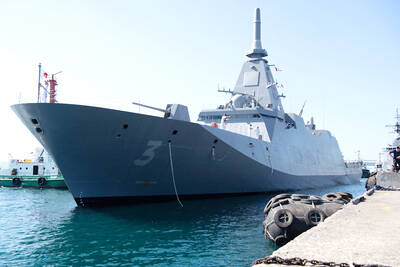One of only four in the world, the Joint Tactical Ground Station sits in a field of snow behind the high fences of this remote base in northern Japan like a windowless trailer home with a few good satellite dishes out back.
It's not impressive. But this is the front line.
In a multibillion-dollar experiment, Japan and the US are erecting the world's most complex ballistic missile defense shield, a project that is changing the security balance in Asia and has deep implications for Washington's efforts to pursue a similar strategy in Europe, where the idea has been stalled by the lack of willing partners.

PHOTO: AP
The station here is the newest piece in the shield.
"Japan is one of our strongest allies in the ballistic missile defense arena," said Brigadier General John Seward, the deputy commanding general of operations for the US Army Space and Missile Defense Command.
In a recent mock-up of how it would work, US military satellites detect a flash of heat from a missile range in North Korea, and within seconds computers plot a rough trajectory across the Sea of Japan that ends in an oval splash-zone outlined in red near Japan's main island.
In a real-world crisis, the next 10 minutes or 15 minutes could be the beginning of an all-out shooting war. Millions could die. Or, two missiles could collide in mid-air over the ocean.
Washington and Tokyo are banking on the idea that early warning of the kind provided by the Joint Tactical Ground Station (JTAG) and another state-of-the-art "X-band" radar station recently deployed nearby will lead to the latter. They are pouring a huge amount of resources -- the US Missile Defense Agency is seeking an US$8 billion budget this year -- into establishing a credible warning and response network.
Though Washington's focus and world attention has shifted to Iran, North Korea has over the past several years made major strides in its development of nuclear weapons and the means to deliver them to the shores of other countries.
In October 2006, it conducted its first nuclear test -- a step that Iran has not taken -- and more than a decade ago shot a multistage ballistic missile over Japan's main island and well into the Pacific, almost reaching Alaska.
Japan's concerns are obvious: Its islands arc around the Korean Peninsula and relations between Pyongyang and its former colonial ruler have never been good.
But the threat to the US is also pressing.
Under a mutual security pact, the US has about 50,000 troops deployed around Japan -- all within reach of North Korea's missiles.
The US military last year deployed a Patriot missile battalion to Kadena Air Base, on Okinawa. The US and Japanese navies have also increased their ability to intercept ballistic missiles from sea-based launchers.
In a test off Hawaii last month, Japan became the first country after the US to shoot a missile out of the air with a ship-launched SM-3 interceptor. Japan hopes to equip its ships with such interceptor missiles over next several years.
The sea-based interceptors, which have a longer range than land-based Patriots, are Japan's first line of defense.
Seward said he hopes the alliance with Tokyo on ballistic missile defense will serve as a model for the world.
The US operates its three other JTAGs in Germany, Qatar and South Korea.

Eleven people, including a former minister, were arrested in Serbia on Friday over a train station disaster in which 16 people died. The concrete canopy of the newly renovated station in the northern city of Novi Sad collapsed on Nov. 1, 2024 in a disaster widely blamed on corruption and poor oversight. It sparked a wave of student-led protests and led to the resignation of then-Serbian prime minister Milos Vucevic and the fall of his government. The public prosecutor’s office in Novi Sad opened an investigation into the accident and deaths. In February, the public prosecutor’s office for organized crime opened another probe into

RISING RACISM: A Japanese group called on China to assure safety in the country, while the Chinese embassy in Tokyo urged action against a ‘surge in xenophobia’ A Japanese woman living in China was attacked and injured by a man in a subway station in Suzhou, China, Japanese media said, hours after two Chinese men were seriously injured in violence in Tokyo. The attacks on Thursday raised concern about xenophobic sentiment in China and Japan that have been blamed for assaults in both countries. It was the third attack involving Japanese living in China since last year. In the two previous cases in China, Chinese authorities have insisted they were isolated incidents. Japanese broadcaster NHK did not identify the woman injured in Suzhou by name, but, citing the Japanese

YELLOW SHIRTS: Many protesters were associated with pro-royalist groups that had previously supported the ouster of Paetongtarn’s father, Thaksin, in 2006 Protesters rallied on Saturday in the Thai capital to demand the resignation of court-suspended Thai Prime Minister Paetongtarn Shinawatra and in support of the armed forces following a violent border dispute with Cambodia that killed more than three dozen people and displaced more than 260,000. Gathered at Bangkok’s Victory Monument despite soaring temperatures, many sang patriotic songs and listened to speeches denouncing Paetongtarn and her father, former Thai prime minister Thaksin Shinawatra, and voiced their backing of the country’s army, which has always retained substantial power in the Southeast Asian country. Police said there were about 2,000 protesters by mid-afternoon, although

MOGAMI-CLASS FRIGATES: The deal is a ‘big step toward elevating national security cooperation with Australia, which is our special strategic partner,’ a Japanese official said Australia is to upgrade its navy with 11 Mogami-class frigates built by Japan’s Mitsubishi Heavy Industries, Australian Minister for Defence Richard Marles said yesterday. Billed as Japan’s biggest defense export deal since World War II, Australia is to pay US$6 billion over the next 10 years to acquire the fleet of stealth frigates. Australia is in the midst of a major military restructure, bolstering its navy with long-range firepower in an effort to deter China. It is striving to expand its fleet of major warships from 11 to 26 over the next decade. “This is clearly the biggest defense-industry agreement that has ever